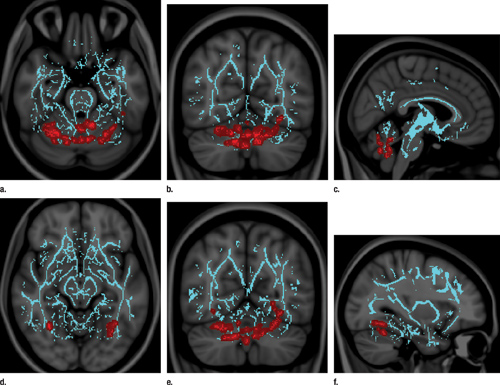OAK BROOK, Ill. – Researchers using information provided by a magnetic resonance imaging (MRI) technique have identified regional white matter damage in the brains of people who experience chronic dizziness and other symptoms after concussion.
The findings suggest that information provided by MRI can speed the onset of effective treatments for concussion patients. The results of this research are published online in the journal Radiology.
Concussions, also known as mild traumatic brain injury (mTBI), affect between 1.8 and 3.8 million individuals in the United States annually.
One of the most common and debilitating effects of concussion is vestibulopathy, a condition characterized by dizziness, imbalance and visual problems. Vestibulopathy impairs activities of daily living and puts patients at increased risk for a second injury. Up until now, no specific brain regions have been linked to the prognosis of patients with vestibulopathy.

Vestibular disturbances correlate with decreased FA in cerebellar regions responsible for sensorimotor processing and central and/or axial balance as well as fusiform gyrus, which is responsible for visually guided locomotion and stereoscopic vision. Images derived from TBSS results and rendered on T1- weighted images from Montreal Neurologic Institute atlas indicate that significant white matter differences in patients with mild TBI and vestibular symptoms involve (a–c) lobule VI and vermian lobules VIIIa, VIIIb, and IX, as shown in axial (a), coronal (b), and sagittal (c) planes, and (d–f) fusiform gyri bilaterally, as shown in axial (d), coronal (e), and sagittal (f) planes. Significant voxels (P .05, corrected for multiple comparisons) were thickened by using TBSS fill function into local tracts (red) and overlaid on white matter skeleton (blue).
For the study, the researchers retrospectively reviewed imaging data from 30 mTBI patients with vestibular symptoms and 25 with ocular convergence insufficiency, a condition that occurs when the eyes don't turn inward properly when focusing on a nearby object. Controls consisted of 39 mTBI patients without vestibular abnormalities and 17 with normal ocular convergence. The imaging data was acquired using an MRI technique called diffusion tensor imaging (DTI), which produces a fractional anisotropy (FA) value that can be used to determine damage to the brain's signal-transmitting white matter.
"FA provides a measure of how intact the white matter is," said Lea Alhilali, M.D., from the University of Pittsburgh Medical Center. "The lower the FA value, the more injured the white matter is."
When Dr. Alhilali and colleagues compared the DTI results, they found that the concussion patients with vestibular symptoms had decreased FA values in brain regions not previously suspected to be involved in post-traumatic vestibulopathy.
"Patients with vestibular symptoms had white matter injury in the cerebellar area, which is known to control balance and movement, and also in the fusiform gyri, a brain area that integrates the visual fields of the left and right eye and is important to spatial orientation," she said.
The findings appear to show a connection between vestibulopathy and regional brain damage, Dr. Alhilali added.
"Vestibulopathy was previously thought to be related to the inner ear structure," she said. "What's unique about our study is that it shows that, in these patients, there is also injury to the brain itself."
The researchers also found that injury to the cerebellar area was associated with a lengthier recovery time.
The findings have the potential to change the clinical management of vestibulopathy in concussion patients, Dr. Alhilali said. For example, DTI results could be used alongside neurocognitive testing to help determine a patient's prognosis and begin appropriate treatments.
"Vestibular therapy is often very effective," Dr. Alhilali said. "Using DTI findings, we can treat patients earlier and get them back to a baseline state much sooner."
The researchers have two goals in the near term, Dr. Alhilali said. First they want to identify brain injuries associated with other post-concussion symptoms, and then they hope to conduct prospective studies to track patients from shortly after their concussions through recovery.
"Concussion is not just one pathology, but many different injuries with different symptoms," Dr. Alhilali said. "Not every case is the same, and we need to treat each patient individually."